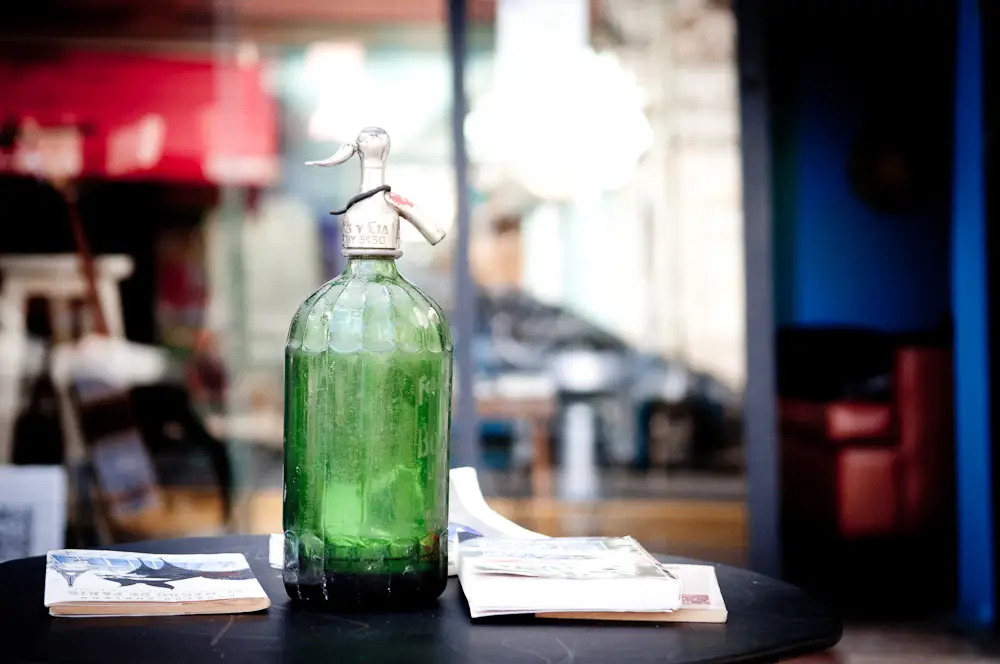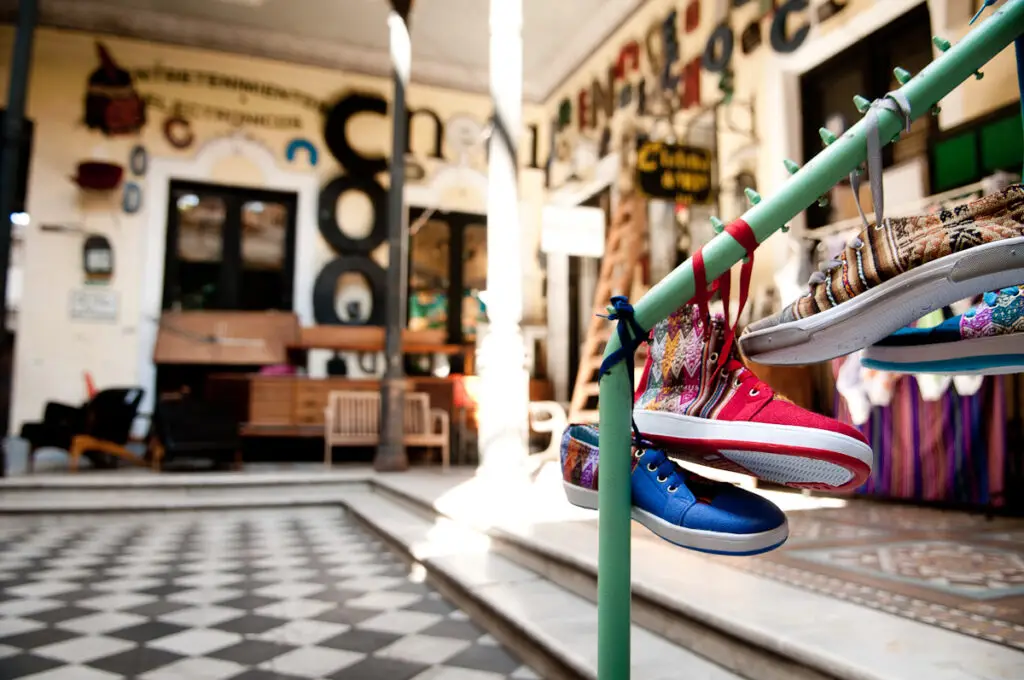



There are parts of Buenos Aires that still feel very much like other parts of the world. Taking a nighttime stroll through Corrientes avenue will remind you of parts of Broadway, and the architecture in various parts of the city is clearly and identifiably Parisian. But there are also parts of town that feel very uniquely Buenos Aires, where the city’s culture and history collide in a joyfully chaotic jumble of art, music, and tradition. San Telmo is one such neighborhood, featuring beautiful colonial style architecture (some of the oldest in the city), a bustling Sunday fair, museums, tango, antique shops, and top quality restaurants; it is easily one of the most exciting places to visit if you want to get an authentic taste of Buenos Aires.
Walking through the cobblestone streets of San Telmo, there’s a sense of romanticism to it all; a strong feeling of lived-in history that transcends the hegemonic tendency towards modernization. Even as the modern world tugs at its sleeves, San Telmo has retained its identity thanks to the effort of preservationists; in 2012, a law came into effect protecting the city’s historic buildings, deeming them culturally valuable and encouraging their preservation.
In its earliest incarnation, San Telmo (then known as San Pedro Heights) was home to dock workers and brick makers. It was the first industrial part of town, leading to the first residential settlements in the area. Immigration during the late 19th and early 20th centuries breathed new life into the neighborhood, which led to it becoming the bustling cultural hotspot it is today.
San Telmo is perhaps most renowned for the famous Feria de San Telmo, which happens every Sunday along Calle Defensa from Plaza Dorrego all the way to Plaza de Mayo. This is a huge street bazaar that has been happening since the early 1970s.. Not only will you be able to take in the art and culture (you’ll see street performers aplenty), but it’s also a prime spot for some shopping: Hundreds of vendors line the street selling all kinds of goods; everything from antiques, leather bags, knick-knacks, musical instruments, collectibles, vintage clothing, furs, and assorted weirdness.
As you make your way through the different stands and the artists alley, you might find an item you want and feel like you can get a better price for. You might feel inclined to haggle.
• Generally, we would recommend not doing this for art, as you may insult the artist. Only do it if you are buying in quantity.
• Other types of vendors might be open to the idea, but it’s always better if you’re buying multiple of the same item.
• Maybe use USD as a bargaining chip, but exercise caution; this might spark anti-American sentiment, as the issue of currency is somewhat of a sore topic in Argentina.
This fair was originally focused on antiques, but as the years have gone on, it’s grown to encompass much more; vintage street signs, gold watches, vinyl records, paintings, all manner of souvenirs. This is truly the place to go if you want to bring some gifts back to friends and family, as you’re guaranteed to find something good for just about every taste.
Note: if you’re in the mood for some live tango, if you stick around Plaza Dorrego until around 9 PM, you’ll be able to enjoy the widely-lauded milonga that happens there every Sunday night. (What’s a milonga?)
If you happen in San Telmo any other day of the week and you want to do some shopping, you can head on over to the San Telmo Market. This historic indoor market is a permanent fixture that opens every day, as opposed to the temporary outdoor market that lines Defensa street and Plaza Dorrego only on Sundays. Much like the fair, however, the San Telmo Market is a fantastic opportunity to buy everything from fur and leather goods to highly unusual trinkets (one of the shops specializes in old toys, so when you come upon it you are greeted by an army of dead-eyed baby dolls, which is as fascinating as it is disturbing). You can also buy fresh produce to take home, or have a bite to eat at the several restaurants that operate within it.
Update 2025: As the years pass the indoor San Telmo Market “El Mercado de San Telmo” has begun to attract more and more restaurants and generic offerings. The once eclectic mix of shopkeepers have transitioned to more and more international offerings.

The Market was first started in the late 1890s to cater to the needs of the new wave of immigrants who’d taken residence in San Telmo; the building has been renewed, but its industrial appearance and structure remains intact, so stepping into the San Telmo Market still feels very much like stepping into a time machine. For a further dive back into Buenos Aires history, you can rummage through the vintage art and old pictures of the city that are for sale, or maybe pick up a Tango record for the collection at the record store. It’s also a cool spot for an afternoon coffee or beer as the afternoon sun sneaks in through the dusty windows and pillars of the old wrought iron roof.
San Telmo is full of good restaurants and cafes. While you’re in the San Telmo Market, you should definitely check out:
1. Coffee Town, which is renowned as one of the best coffee spots in the entire city.
2. If you’re hungry for some authentic Argentine parrilla, head on over to Lo De Freddy (Bolívar 950), a tiny hole-in-the-wall with a delightfully dingy San Telmo ambiance that serves some of the most delicious choripanes (a chorizo sandwich) and bondiolas (pork shoulder sandwich) you will ever find, as well as several other delicious cuts of meat.
3. You could also try out El Desnivel (Defensa 855), which is a large steakhouse that’s famous for its generous portion sizes and high quality beef.

4. Another great spot to try is El Banco Rojo (Bolivar 866), a widely lauded fast food joint where you can get incredible shawarma, delectable burgers as well as deep fried spicy lamb empanadas among other things.
5. Café La Poesía (Chile 502) is a delightful little spot famous for being where the thinkers and artists of San Telmo congregated to share poetry and contemplate democracy after the end of Argentina’s military dictatorship.
6. On the other end of the spectrum, La Brigada (Estados Unidos 465) is a famous fútbol-themed steakhouse that, despite its touristy sheen, still grills some of the best steaks in Buenos Aires, and the decor makes for a wonderful picture-taking spot.
Among the things you can do in San Telmo, you could take in some live music! La Trastienda (Balcarce 460) is one of the largest music venues there, usually hosting shows by rock artists, both local and international. Another great option is Clásico Fernández (Piedras 1020), which has an aesthetic that can best be described as a cross between a jazz club and a punk dive, fitting neatly in with San Telmo’s mish-mashy feel. This is a lovely bar that features quieter, mostly acoustic performances by up-and-coming and established musicians. Xirgu Espacio UNTREF (Chacabuco 875) is a gorgeous historic theater that also features a lot of live music by an eclectic array of musicians.
All in all, San Telmo is one of the most interesting, culturally and artistically rich neighborhoods of Buenos Aires, and you’d be doing yourself a disservice by skipping it during your time in the city. For a thorough look at the neighborhood San Telmo.
(US) 910 795 2992
(AR) +54 9 11 —- —-
©Copyright 2025 Landingpadba, LLC